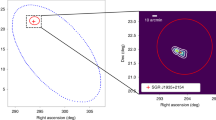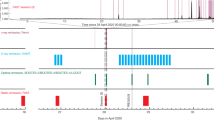Abstract
RESULTS from the Burst and Transient Source Experiment (BATSE)1 on the Compton Gamma-Ray Observatory show a relative deficiency of faint γ-ray bursts without any detectable anisotropy. This gives strong support to suggestions that the bursts originate at cosmological distances2, such that cosmic expansion reduces the detectability of faint (and therefore distant) sources relative to a uniformly filled euclidean space. But the Pioneer Venus Orbiter (PVO) observations of brighter bursts show no such deficiency, indicating that the bursts that it sees are at redshifts less than about one. The best-fit cosmological model based on PVO data (peak luminosity L0 = 2 x 1050erg s-1) with no evolution of the source population predicts, when extrapolated to the fainter sources, a factor of 40 more events than BATSE sees. Even the 3a limit from PVO (L0 = 9.1 x 1051 ergs-1) is barely consistent with the BATSE result. Evolution of the cosmological γ-ray burst sources with epoch therefore seems necessary if the PVO and BATSE data are to be reconciled. The required evolutionary trend is for fewer or fainter bursts at larger redshift.
This is a preview of subscription content, access via your institution
Access options
Subscribe to this journal
Receive 51 print issues and online access
$199.00 per year
only $3.90 per issue
Buy this article
- Purchase on Springer Link
- Instant access to full article PDF
Prices may be subject to local taxes which are calculated during checkout
Similar content being viewed by others
References
Meegan, C. A. et al. Nature 355, 143–145 (1992).
Paczynski, B. Astrophys. J. 308, L43 (1986).
Babul, A., Paczynski, B. & Spergel, D. Astrophys. J. 316, L49–L54 (1987).
Zdziarski, A., Svensson, R. & Paczynski, B. Astrophys. J. 366, 343–352 (1991).
Chuang, K. thesis, Univ. of California at Riverside (1989).
Hartmann, D. in Gamma-Ray Bursts: Observations, Analyses, and Theories (eds Ho, C., Epstein, R. & Fenimore, E. E.) 45 (Cambridge University Press, 1991).
Fenimore, E. E. et al. Proc. Huntsville Gamma-Ray Burst Workshop (eds Paciesas, W. & Fishman, G.) (AIP, in the press).
Chuang, K. et al. Astrophys. J. (in the press).
Lampton, M., Margon, B. & Bowyer, S. Astrophys. J. 208, 177–190 (1976).
Weinberg, S. Gravitation and Cosmology (Wiley, New York, 1972).
Mao, S. & Paczynski, B. Astrophys. J. (submitted).
Paczynski, B. Proc. Huntsville Gamma-Ray Burst Workshop (eds Paciesas, W. & Fishman, G.) (AIP, in the press).
Schaefer, B. E. in Gamma-Ray Bursts: Observations, Analyses, and Theories (eds Ho, C., Epstein, R. & Fenimore, E. E.) 207 (Cambridge University Press, 1991).
Author information
Authors and Affiliations
Rights and permissions
About this article
Cite this article
Fenimore, E., Epstein, R., Ho, C. et al. Necessity of evolution in cosmological γ-ray bursts. Nature 357, 140–141 (1992). https://doi.org/10.1038/357140a0
Received:
Accepted:
Issue Date:
DOI: https://doi.org/10.1038/357140a0
This article is cited by
-
Gamma-rays from neutron stars
The Astronomy and Astrophysics Review (1995)
-
The intrinsic luminosity of γ-ray bursts and their host galaxies
Nature (1993)
-
Gamma-ray bursts from nearby neutron stars
Astrophysics and Space Science (1993)
-
Gamma-ray bursts from high-velocity neutron stars
Nature (1992)
-
Receding from our grasp
Nature (1992)
Comments
By submitting a comment you agree to abide by our Terms and Community Guidelines. If you find something abusive or that does not comply with our terms or guidelines please flag it as inappropriate.



